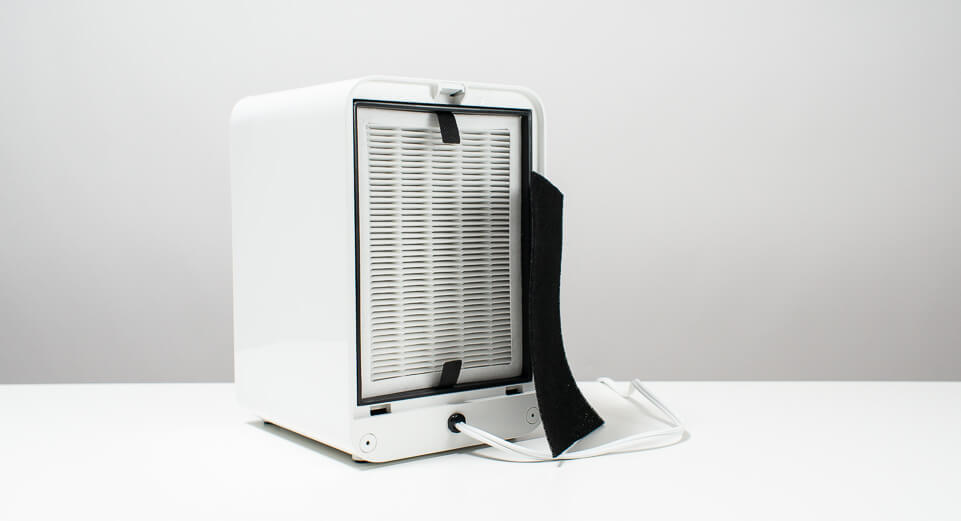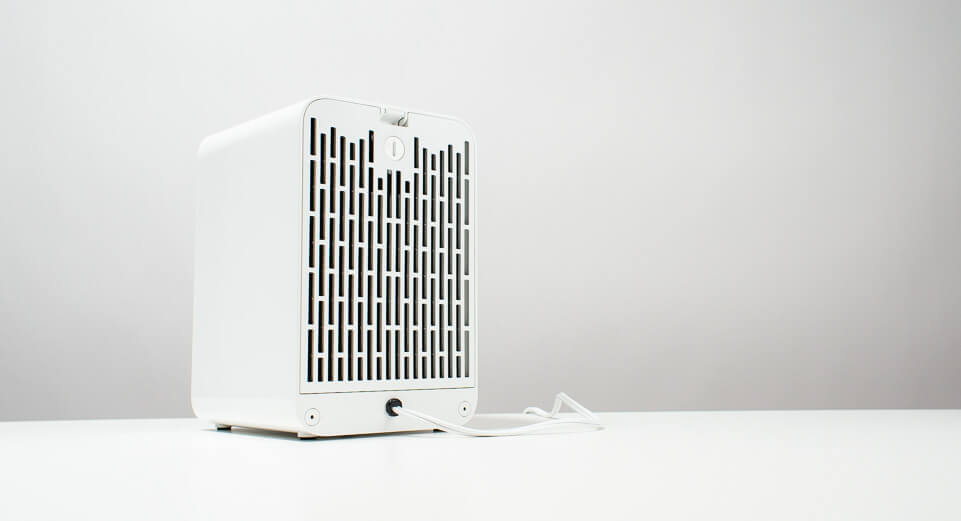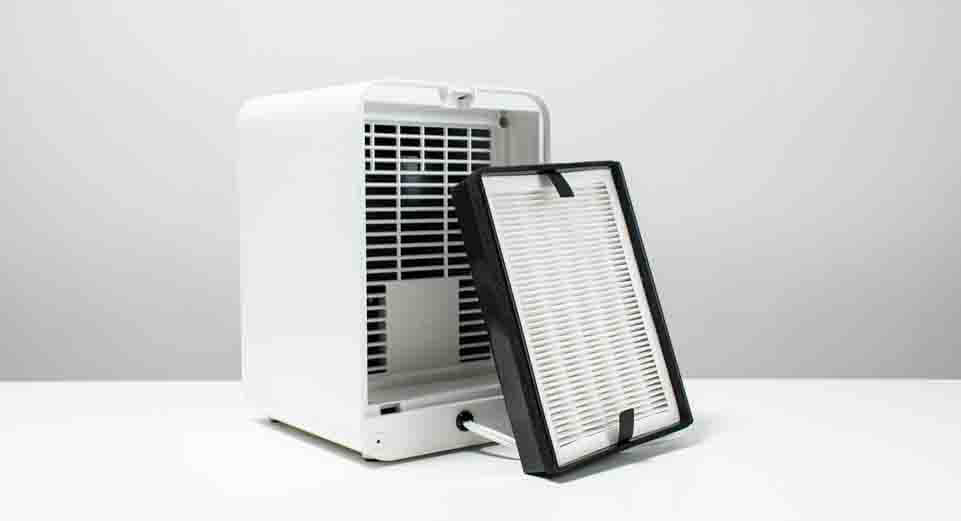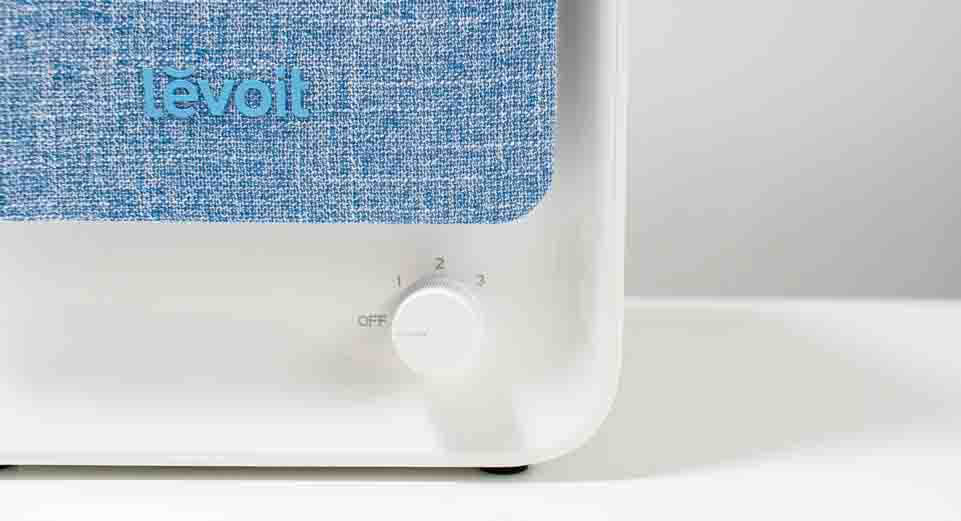Levoit LV-H126 Review

Feature Scores
Pros
- Small and light weight – one of the most portable air purifiers on the market
- No lights that turn on – can be used in a dark room at night with no illuminating LEDs to bother you while you’re sleeping
- True HEPA filter at a very low price point
Cons
- Low output – can only be used in extremely small spaces – under 100 sq. ft.
- Poor energy efficiency – draws a lot of power considering its low output
Editor's Score
Quick Facts
| Particle filter type | HEPA |
|---|---|
| Gas filter type | Carbon |
| Pre-Filter | Foam |
| Output | Approx. 50 to 80 CFM |
| Air Movement | Back grille > foam pre-filter > HEPA filter > carbon filter > front grille |
| Number of fan speeds | 3 – low, medium, high |
| Size | 10.5 in. tall x 7 in. wide x 8 in. deep |
| Weight | 4.5 lb. |






Analysis
A step by step breakdown of the LV-H126's performance.
Air Processing Performance
Test Results
In a 150 sq. ft. test environment the Levoit LV-H126 lowered room particle concentration from 10,000 particles per cubic ft. (dirty air) down to 3,800 particles per cubic ft. (cleaner air) in 27 minutes. Given an additional hour of run time the unit could not get the room particle concentration any lower than 3,800 particles per cubic ft. This was the lowest room particle concentration it was able to achieve.
For comparison, the GermGuardian AC4100 (probably the LV-H126’s closest competitor as it has a very similar output, size, and price) took 44 minutes to get the room particle concentration down to 3,800 particles per cubic ft. It also could not get room particle concentration any lower, even after being given several additional hours of run time.
Units with greater output - the ability to process a greater amount of air per unit time (greater CFM) – cleaned the air in the test environment much faster and achieved a much lower room particle concentration.
For example, the approx. 140 CFM GermGuardian AC4825 took 23 minutes to lower room particle concentration from 10,000 particles per cubic ft. (dirty air) down to 1,000 particles per cubic ft. (much cleaner air than the 3,800 particles per cubic ft. air the Levoit was able to achieve). The GermGuardian, given additional run time – in this case, 40 additional minutes - was able to achieve a room particle concentration of 500 particles per cubic ft.
More expensive options were even faster and achieved an even lower room particle concentration. For example, the approx. 250 CFM Winix 5500-2 took only 9 minutes to lower room particle concentration from 10,000 particles down to 1,000 particles per cubic ft. Given an additional 6 minutes, it was able to get room particle concentration down to the ultra-low level of 100 particles per cubic ft.
So, in summary, low output units (outputting at well under 100 CFM) like the Levoit LV-H126 and GermGuardian AC4100 took upwards of 27 minutes to lower room particle concentration only down to 3,800 particles per cubic ft. A full-size air purifier (outputting at approx. 250 CFM) like the Winix 5500-2 lowers room particle concentration down to 100 particles per cubic ft. in about 15 minutes.
Filter Analysis

Particle Filter
The LV-H126 is equipped with a true HEPA filter to remove particles like dust, mold spores, and allergens. HEPA filters have a standard efficiency of 99.97% - they are able to remove 99.97% of particles that travel through them. The LV-H126’s HEPA filter is just as efficient.
The AC4100 is also equipped with a HEPA filter. So is the GermGuardian AC4825 and Winix 5500-2. HEPA filters are the most commonly used particle filters on the market. Even the approx. $900 IQAir HealthPro Plus uses a HEPA filter – with 99.97% efficiency.
Why then, did the LV-H126 perform so poorly in our particle removal testing? The answer is simple – it has a very small HEPA filter and a very low output.
Filtering out particles from the air requires two things: a filter and moving air through the filter. The LV-H126 doesn’t move enough air through a sufficiently large HEPA filter to properly lower particle concentration in a 150 sq. ft. room. That is why it performed poorly in our tests.
Gas Filter
Like most other air purifiers on the market, the LV-H126 is equipped with a carbon filter for the purpose of gas filtration – removing unwanted gases like VOCs and odors.
Like its HEPA filter, its carbon filter is also very small. For this reason, there’s not a lot of filtration media contained within the carbon filter.
The LV-H126 is certainly capable of removing VOCs and odors with its carbon filter, but don’t expect it to be effective in any space larger than 100 sq. ft. For larger spaces we recommend a unit with greater output and a much larger carbon filter that contains much more gas filtration media. The Winix 5500-2 would be our recommendation here if you’re looking for a unit that filters gases reasonably well in spaces up to 300 sq. ft. but is still highly affordable.
Pre-filter
The LV-H126 is equipped with a foam pre-filter. Most other air purifiers at its price point do not have a separate pre-filter. The AC4100 and AC4825 both have a fibrous carbon filter that doubles as a pre-filter.
The pre-filter’s job is to capture larger particles and fibers before they reach the HEPA filter. This extends the life of the HEPA filter as it would otherwise saturate with these larger particles very quickly.
On the LV-H126 the foam pre-filter works well to capture these larger particles. It can easily be vacuumed and/or rinsed when it saturates with particles. The carbon filters on the AC4100 and AC4825 have to be replaced, at cost, when they saturate with larger particles. So, in this way, the LV-H126’s foam pre-filter will save you money in filter costs over time compared to the AC4100 or AC4825.
Full size units like the Winix 5500-2 usually have a more substantial separate pre-filter. The Winix, for example, has a mesh pre-filter that will take much longer to saturate than the LV-H126’s foam pre-filter, if only because it’s much larger. The mesh pre-filter on the Winix can be vacuumed or rinsed like the LV-H126’s foam pre-filter so there’s no additional costs incurred when these filters saturate like there is with the AC4100 or AC4825.
Air Movement
The LV-H126 processes well under 100 cubic ft. of air every minute (CFM). We were unable to pin down an exact CFM but we estimate it’s somewhere between 60 and 80 CFM. For comparison, the AC4100 has an estimated CFM of about 80.
The AC4825 outputs at approx. 140 CFM and the Winix 5500-2 outputs at approx. 250 CFM.
There’s a direct correlation between air processing power and area of coverage. At approx. 60 to 80 CFM the LV-H126 should be used in any space larger than about 100 sq. ft.
The AC4825’s area of coverage is 150 sq. ft. and the Winix 5500-2 area of coverage is 300 sq. ft.
Note that you cannot put a low output unit like the LV-H126 directly next to you and expect it to create a “clean air bubble” around you. Air and the particles suspended in air moves freely and very easily. As soon as clean air that’s low in particle concentration exits the air purifier, high particle concentration air immediately swoops in to even the concentration out.
When you place an air purifier in a room and turn it on, it lowers particle concentration in the whole room over time – not any more or less in the area immediately surrounding the air purifier. This is why it’s important that you buy an air purifier that has sufficient output for the whole room that you’re trying to purify.
Again, the LV-H126 cannot lower room particle concentration fast enough or to a sufficiently low clean air level in any room larger than about 100 sq. ft. A larger unit like the AC4825 is recommended for spaces up to 150 sq. ft. And an even larger full size unit like the 5500-2 is recommended for spaces up to 300 sq. ft.
Energy Efficiency
The LV-H126 is one of the least energy efficient air purifiers we’ve tested, with very low CFM/watt ratios across the board (across all fan speeds).
On high it draws 40.3 watts of power at well under 100 CFM of output. For comparison, the Winix 5500-2 draws 54.8 watts on turbo at approx. 250 CFM of output. On its second highest fan speed at approx. 100 CFM of output, the Winix draws only 9.8 watts of power.
Note that the LV-H126’s poor energy efficiency is more a product of its size and form factor than its internal components. Most smaller air purifiers we tested had poor energy efficiency while most larger units like the Winix had very good energy efficiency.
Why did this happen? The answer is actually quite simple:
The only component of an air purifier that draws a substantial amount of power is its fan. A smaller unit has a smaller fan that has to be run at a very high speed to move just as much air as a larger unit with a larger fan running at a much lower speed.
The LV-H126’s fan has to be moving at maximum speed at 40.3 watts of power draw to move well under 100 cubic ft. of air per minute. The Winix’s much larger fan can be run at a much lower fan speed and still move approx. 100 cubic ft. of air per minute at a much lower power draw of only 9.8 watts.
The bottom line is this: if energy efficiency is a priority for you, a super small unit like the LV-H126 or AC4100 or even a larger (but still small) unit like the AC4825 just isn’t a good choice. Take a look at larger full size units like the Winix 5500-2 or Coway Mighty instead.
Noise Output
The difference between small and large units we described above also applies here. Recall that a small unit with a small fan has to be run on maximum fan speed to move just as much air as a larger unit with a larger fan that’s running on a lower fan speed.
The LV-H126 had a measured noise output of 62.8 dB on high. The AC4100 had a measured noise output of 63.7 dB on high. Both units output at well under 100 CFM at these noise levels.
The Winix 5500-2 was measured at 48.9 dB on its second highest fan speed where it outputs at approx. 100 CFM.
Thus, the Winix has a measured noise output almost 15 dB less than both smaller units at an even greater total air processing output (CFM).
The same as was true for energy efficiency: if noise output is a priority for you a larger unit like the Winix is a much better option than a smaller unit like the LV-H126. It runs much more quietly at even greater output. Again, this is no fault of the LV-H126 specifically. It’s simply a product of its smaller size. Its small fan has to be run at maximum speed to keep up with the output of larger units with larger fans running at much lower speeds. And lower fan speed equates to quieter operation.
Durability
The LV-H126, for the most part, is a very durable well built appliance. There’s not much to break on this air purifier. It has a single knob that controls fan speeds. The only area of concern is the fabric covering the front grille of the unit which is likely to scratch with continued use over the life time of the air purifier.
Comparing it side by side with the AC4100, the GermGuardian does appear to be slightly better built with slightly higher quality materials, but the difference is minimal.
The Levoit comes with a 1 year warranty and so does the GermGuardian. If warranty length is a priority for you we recommend taking a look at Honeywell (5 year warranty) and Coway (3 year warranty) products.
Ease of Use

The LV-H126’s basic design is not only good for durability. It’s also a good thing if you’re looking for an air purifier without control panel lights. More expensive units like the Winix 5500-2 and Coway Mighty offer a multitude of features like ionization, timers, auto modes, and an air quality sensor. Each of these features come with corresponding control panel lights. Sometimes these lights can be toggled on/off but most of the time they stay on with no option to turn them off.
The LV-H126 has none of these features which means there are no LEDs to illuminate to show whether they’re turned on or off. This means you can put this unit in a dark bedroom at night and don’t have to worry about lights on the appliance illuminating the room.
The LV-H126 is a very light and small air purifier. It’s under a foot tall and well under a foot wide and deep. The unit weighs well under 5 lb.
Do note that while this unit is very small, full size air purifiers are by no means large oversized appliances. For example, the Winix 5500-2 is under 2 ft. tall, only slightly over a foot wide, and well under a foot deep. It weighs only about 16.5 lb.
Is the LV-H126 one of the smallest, lightest, most portable air purifiers we tested? Yes. Is a full size air purifier like the Winix still relatively small, light, and portable? Also, yes.
Value
The Levoit LV-H126 is very inexpensive, retailing for approx. $60. The GermGuardian AC4100 retails for about the same price. The AC4825 retails for about $80. Full size units like the Winix 5500-2 and Coway Mighty usually retail in the $150 to $200 range.
The LV-H126 is cheap but is it a good value? We don’t think so.
First of all, the unit has very low output – well under 100 CFM. Its low output makes it viable only in very small rooms under 100 sq. ft. in size. For about $20 more you can buy the AC4825 which has approx. 140 CFM of output – enough for a rooms up to 150 sq. ft. For approx. $150 you can buy the Winix 5500-2 with approx. 250 CFM – enough for rooms up to 300 sq. ft.
The Levoit also has poor energy efficiency and greater noise output than larger full size units like the Winix.
All in all, we would only recommend this unit (or the AC4100 – between these two units, it’s really a toss-up) if you absolutely cannot spend more than about $60 and you only need to purify the air in a very small space (under 100 sq. ft.). Otherwise, the next best cheapest option is the GermGuardian AC4825. We recommend the AC4825 as the cheapest option for rooms up to 150 sq. ft.
Our overall recommendation is that you save up and purchase a full size top rated unit like the Winix 5500-2. It’s going to provide superior air processing power, better particle and gas filtration, better energy efficiency, and lower noise output than both the Levoit and the GermGuardian AC4825. And best of all it’s still highly affordable, retailing for approx. $150.
Add a Comment
Have a question or comment? Let us know below.

Comments